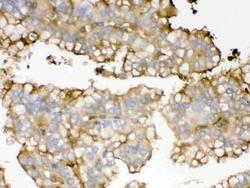Antibody data
- Antibody Data
- Antigen structure
- References [1]
- Comments [0]
- Validations
- Western blot [1]
Submit
Validation data
Reference
Comment
Report error
- Product number
- PB9916 - Provider product page

- Provider
- Boster Biological Technology
- Product name
- Anti-Apolipoprotein A I/APOA1 Antibody Picoband™
- Antibody type
- Polyclonal
- Description
- Polyclonal antibody for APOA I/APOA1 detection. Host: Rabbit.Size: 100μg/vial. Tested applications: ELISA. Reactive species: Human. APOA I/APOA1 information: Molecular Weight: 30778 MW; Subcellular Localization: Secreted; Tissue Specificity: Major protein of plasma HDL, also found in chylomicrons. Synthesized in the liver and small intestine. The oxidized form at Met-110 and Met-136 is increased in individuals with increased risk for coronary artery disease, such as in carrier of the eNOSa/b genotype and exposure to cigarette smoking. It is also present in increased levels in aortic lesions relative to native ApoA-I and increased levels are seen with increasing severity of disease.
- Reactivity
- Human
- Host
- Rabbit
- Vial size
- 100μg/vial
- Concentration
- Add 0.2ml of distilled water will yield a concentration of 500ug/ml.
- Storage
- At -20°C for one year. After reconstitution, at 4°C for one month. It can also be aliquoted and stored frozen at -20°C for a longer time. Avoid repeated freezing and thawing.
- Handling
- Add 0.2ml of distilled water will yield a concentration of 500ug/ml.
Submitted references Comparison of the sensitivity of Western blotting between PVDF and NC membranes.
Xiang Y, Zheng Y, Liu S, Liu G, Li Z, Dong W
Scientific reports 2021 Jun 8;11(1):12022
Scientific reports 2021 Jun 8;11(1):12022
No comments: Submit comment
Supportive validation
- Submitted by
- Boster Biological Technology (provider)
- Main image

- Experimental details
- Western blot analysis of APOA1 expression in human placenta extract (lane 1). APOA1 at 26KD was detected using rabbit anti- APOA1 Antigen Affinity purified polyclonal antibody (Catalog # PB9916) at 0.5 μg/mL. The blot was developed using chemiluminescence (ECL) method (Catalog # EK1002).
- Additional image

 Explore
Explore Validate
Validate Learn
Learn Western blot
Western blot Immunocytochemistry
Immunocytochemistry